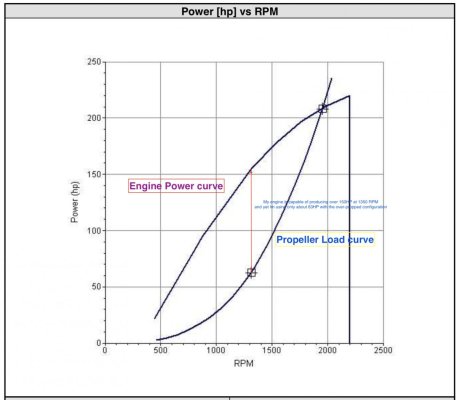Funny enough no one ever asked what is the goal here?
If the goal is maximum speed for WOT, then one should ail roughly to achieve 150-200 RPM less than what high idle of these engines is. So, if High Idle is 2650RPM, then approx 2500 will give you top speed and the engine will be correctly loaded.
Here is the catch: Correctly loaded at WOT! So what percentage of the time you will be driving the boat with WOT? If the answer is more than 5% of the time, then I would prop it as specified above (of course these are rules of thumb, and prop calculation SW will give you the exact results based on engine HP and RPM, transmission ratio, hull WLL, vessel weight, hull type etc.).
But if you don't ever intend to drive the vessel with WOT, this prop-ing will be a waste! It is the save bet, but inefficient setup...
What do I mean by that? The Diesel engines (every engine as am matter of fact) has a torque and HP curve that looks like a hump - see the attached graph. On the other hand, the propeller load curve looks like inverted hump. In the first case with prop calculated for WOT, the loaded RPM HP generation and the propeller load curve should mach at the loaded max RPM, therefore you will not be exceeding allowable load on the engine regardless where the throttle lever is. But if you look at the lower RPM, you will see that the engine is capable of producing tons more power that what the propeller loading curve is requiring at these lower RPM. So what does that mean? It means running your Diesel engine under-loaded for the majority of the time time you are cruising... Not so good! can lead to many issues, such as excessive carbon-ing, cylinders wall glazing, etc. Funny how everyone is more worried about overloading that under loading which takes place in 80-90% of the displacement boats use time.
I put about 12,000NM on my 47' trawler crossing the Pacific Ocean. My major concern when I was preparing for the trip was to make sure I get the most efficiency of my running gear.
So with my goal being efficiency, I decided to over-prop, knowing that I will never be running my engine for long on WOT. Just to be safe, I also installed a pyrometer and it was connected to my vessel monitoring system(
6700 Vitals Vessel System Monitoring & Smart Alarm Device ), that gives you clear indication when your engine is being overloaded.
So my top speed dropped by 1knt after is re-proped with over-proped wheel, but I gained in efficiency. It allowed me to use more of my engine at lower RPM. Praveling with 7.5knts before I needed about 1350RPM. with new wheel configuration, I do 7.5Knts with about 1100RPM. with old prop I could rev to about 2000RPM at WOT, now I can reach only 1800RPM. Due to these changes I managed to go 2,700NM from Cabo San Lucas to the Marquises islands with 912US Gallons.
I do not advice the over-prop your boat, if you want to be safe, but if efficiency is the goal, propping the boat the "safe" way does not going to be optimal. Of course if you decide to over-prop, you or anyone driving the boat should be aware of the "NO WOT" for more than 5-10min rule and definitely have a pyrometer to monitor the EGT while pushing the motor hard at close to WOT.
This is my 25c and my vessel is in NZ now with 12000+ NM over-proper configuration, set for best long range efficiency.

